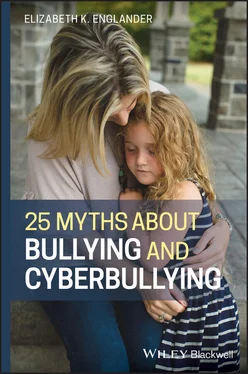To make things more difficult, your own life experiences may also incline you to adopt solutions that may or may not work in this new and different environment. As an eight‐year‐old, you probably didn't have to deal with mean comments while playing an online game; but maybe you were in a playground bullying situation, and you hit the bully, who subsequently decided to leave you alone. Can these experiences help your child today? What happened to you was emotionally powerful – you remember it – but will that strategy still apply? It's not likely that any expert or school will recommend hitting back, but it's also undeniably true that some bullying situations involve an aggressor who seeks defenseless targets, and when they do hit back, that bully just might – maybe – pursue a different victim.
So maybe it worked for you. Will it work for your child? Even a cursory search will quickly show you that many experts – including myself – don't encourage this as a tactic that's likely to work. The point here isn't whether or not to hit; it's that the advice you read may directly contradict your own (admittedly powerful) experience. Clarifying explanations would be helpful, but they aren't always there, or aren't always clear. (The reason, by the way, that I personally don't recommend hitting back is that in the current climate, this strategy is likely to backfire. The first thing a bully may do is go tell an authority figure that he's been hit, and now the original target will be the one in trouble. Not only that, the bully can easily take revenge online.)
Faced with all this – the contradictions, the inapplicability of your own experiences, and the lack of traditional parenting support (read: your own parents) – you could easily end up fruitlessly debating the situation in your own mind. Your own experiences matter, but maybe they were more relevant in a bygone world; one expert says one thing, another has entirely different advice. Maybe if your child hits back, it'll just worsen the entire situation. On the other hand, if he succeeds, perhaps the experience will increase his self‐confidence immensely. This back‐and‐forth is all well and good in academic circles; but in real life, faced with a crisis, it can add to the frustration instead of helping resolve the problem.
Bullying and cyberbullying certainly aren't the only areas of parenting that feature a great deal of competing advice, but it's a notable challenge because the problems are often totally unexpected and can feel incomprehensible. Other areas of parenting that invite differing opinions may not be so complex or changeable. Should you make children eat vegetables? Allow them to sleep in your bed? Send them to a private school? Make them clean up the kitchen? Even the most widely agreed‐upon issues are sometimes debated. Most people encourage kids to share, but a mom once asked me, “Why should I make my kids share? Grownups never have to share anything.” 4 You may or may not have the answers for all the typical dilemmas like these, but at least you understand the questions. In the case of bullying, though, the quagmire of information makes it unclear what we're actually talking about. What is social cruelty? It can be a problem that will simply pass – but we're also told it can be permanently scarring. A 2015 review of the long‐term studies on bullying concluded that bullying had negative effects on a target's emotions, cognitions, and relationships. 5 And what is the right response? Intervening can be destructive in some situations but helpful in others. How can you tease apart the serious situations where not intervening could lead to serious depression or problems, versus a transient episode where your child (or you!) could learn to stand up and be assertive? If you do intervene, you might be crippling an emerging ability to defend oneself; but if you don't intervene, you might be risking emotional, social, and even academic problems.
The myths that surround bullying and cyberbullying foster all these dilemmas and frustrations, and they’re what I'm going to tackle here. I could talk about 25 facts; but instead, I'm going to discuss 25 pieces of misinformation that are common but that also might be hampering your ability to clearly understand and effectively cope with these problems. Generally speaking, these aren't what I would call senseless myths, like believing that bullies are possessed by demons. Our modern‐day myths about bullying and cyberbullying often were once helpful pieces of information; put simply, bullying and cyberbullying have changed so much in the last 15 years that it's hard for the advice to keep pace. But it's important to have accurate information. As adults, we won't be able to prevent or intervene in bullying and cyberbullying if we can't accurately identify and respond to it. If you don't know, for example, what types of psychological bullying or cyberbullying are the most common types, you won't know what to look for, you might not recognize it when it happens, and you won't be able to help your child form coping strategies.
But just the facts (or just the myths) aren't enough, for a few reasons. First, in real life, while there are always notable exceptions to the rule, sometimes we confuse the exception and the rule. It's hard to know what's common and what's rare. As an example, take the fact that most bullying today is psychological, not physical. This trend is undeniable – even by 2012, 88% of the incidents I studied in my research were psychological in nature. But that doesn't mean every single case is only psychological. If you vividly recall being physically bullied as a child, the intensity of that memory makes it hard to accept the idea that bullying today isn't, for the most part, physical. When your own child is being shoved into his locker at school every day, it's hard to believe that his experience is actually much less common, and even harder to see why such trends matter. (Indeed, in that case, they might not.) The facts about bullying and cyberbullying aren't absolute – they are guidelines, but important ones, since they help us know what to look for and how to react when we find it. If you read somewhere that “torn clothing” is a good indication of bullying, you're going to fail to notice an awful lot (since verbal bullying and cyberbullying obviously don't tear anyone's clothes). No one type of bullying accounts for 100% of the cases, but the best way to identify bullying is still to learn to recognize where and how it's most likely to be manifested. Ultimately, parents need to know the facts, the frequent variations, and the personal and emotional experiences that can surround these issues.
The second reason it's not enough to simply list facts about bullying and cyberbullying is that such an approach ignores the reality that these behaviors are sometimes associated with other, much more devastating, outcomes (such as severe emotional damage and even death). Does bullying cause depression and possibly suicide? Does it cause homicidal behavior? When a particular incident (usually in the news media) seems to highlight a possible association between bullying and a catastrophic outcome, it can be difficult to shake the feeling that bullying is terribly dangerous, even if you have the facts at your fingertips. Bullying may not often contribute to suicide, but if you have a depressed, bullied child, that may be a risk you're not willing to ignore. (Nor should you.) When the stakes are high, we're motivated to pay attention even to small probabilities. Consider: overall, it's not likely that you'll die in a car crash; but even so, no one denies the value and importance of safety belts.
Understand the myths, because myths can ultimately impede your ability to cope and your ability to help your child learn to cope. Thinking that a catastrophic outcome (like suicide) is common – when it's not – can invoke paralyzing anxiety and fear. You're so scared of suicide that you might ignore the bullying. Lack of knowledge can mean using the wrong tactics, or none at all. Maybe you encourage your child to hit back, and she is subsequently suspended from school. Not knowing what to look for can cause either over‐attribution (characterizing something that's not bullying as bullying) or under‐attribution (failing to see bullying or cyberbullying when it happens).
Читать дальше












